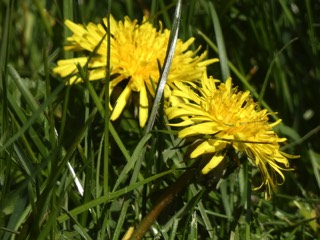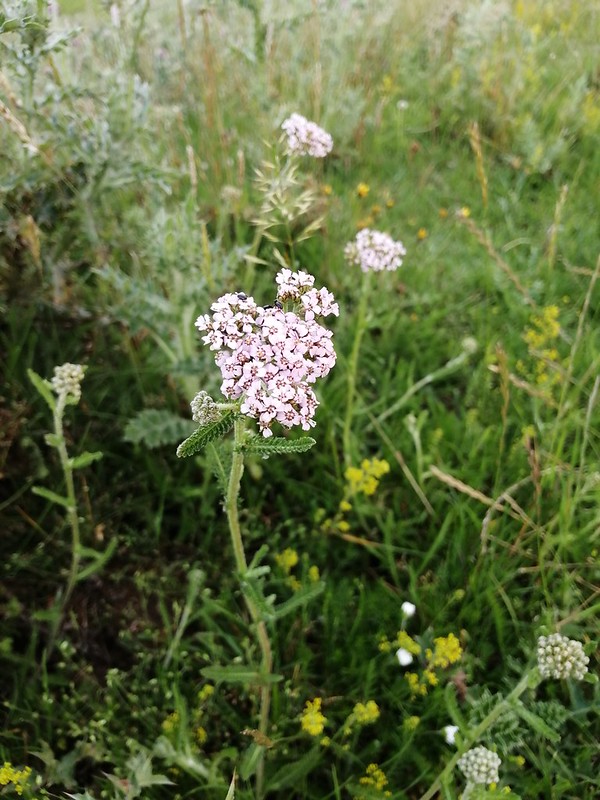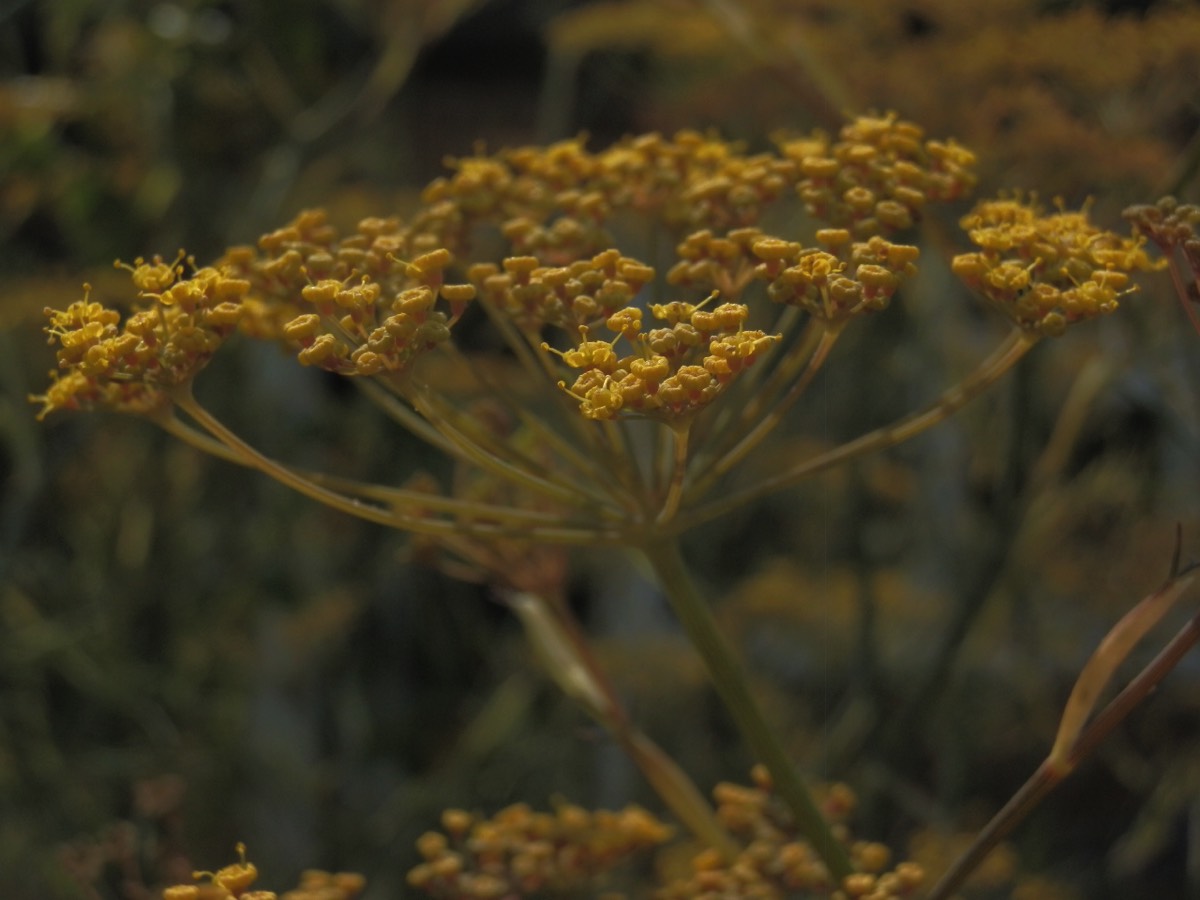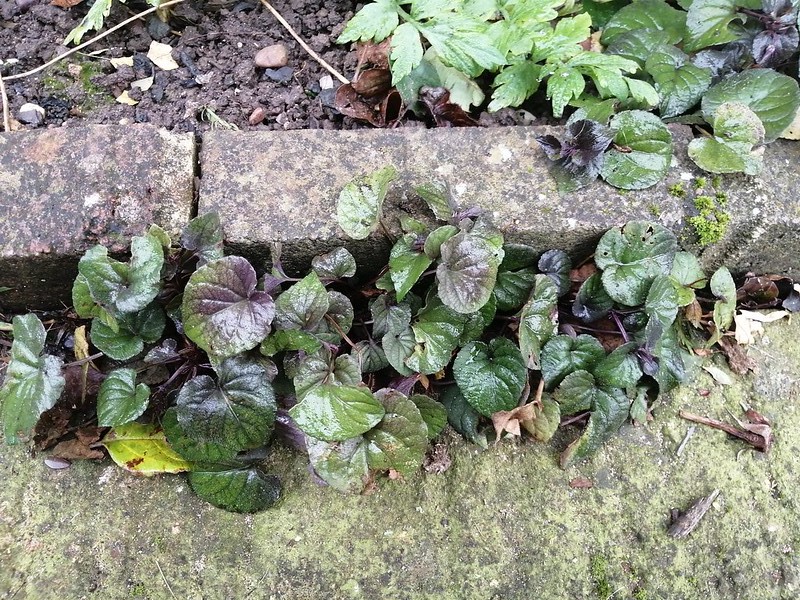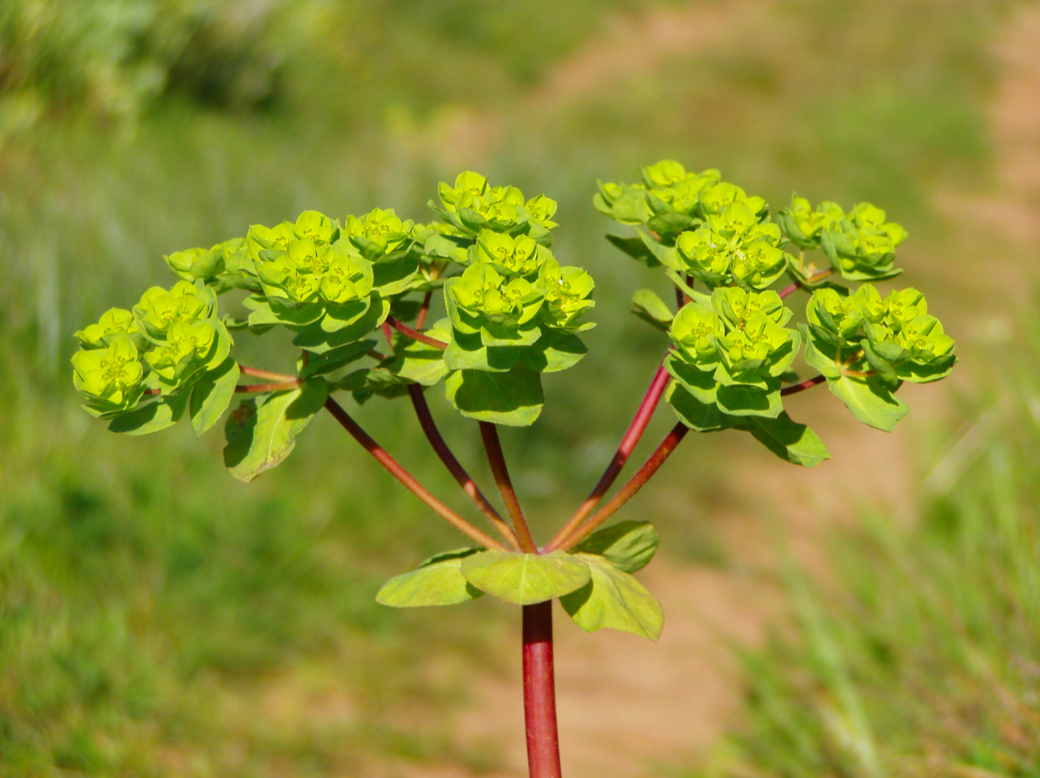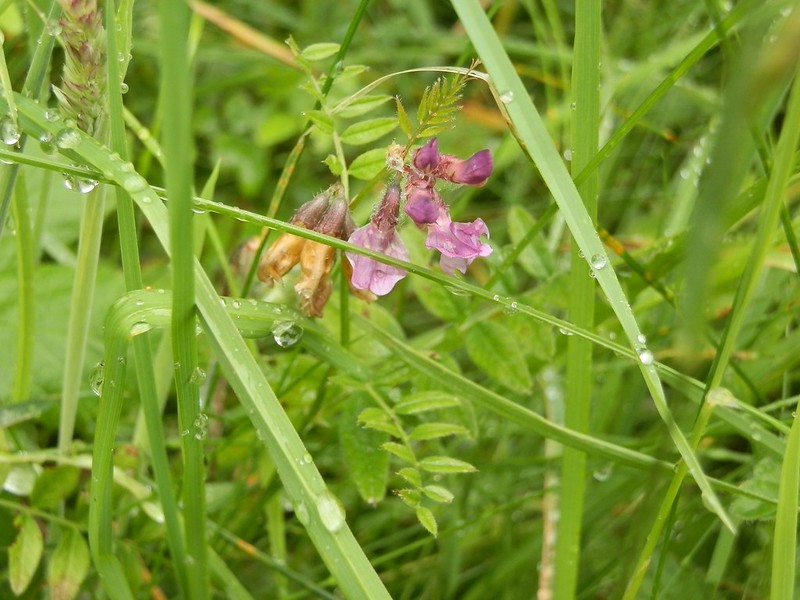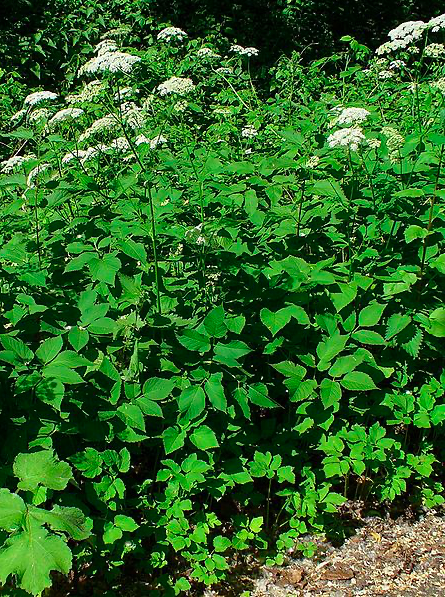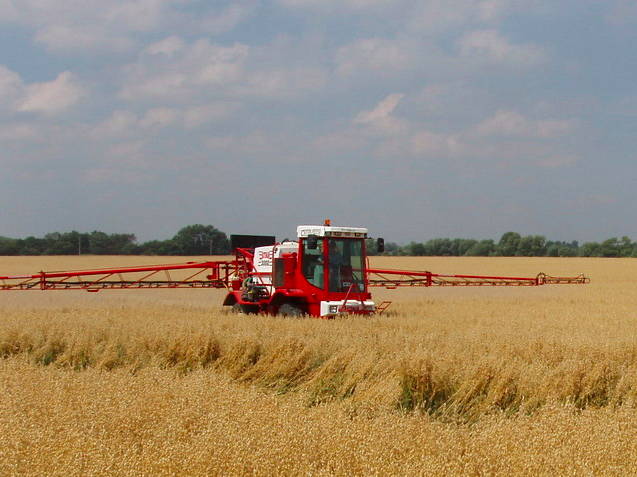Managing Your Weeds
The UK has a long and proud history as a gardening nation, but unfortunately, this tends to be bound up with a belief that weeds are the enemy and a good gardener gives them no quarter. New gardeners and allotmenteers begin with the expectation that they must first clear all the weeds on their patch, with a combination of chemical warfare and heavy digging. Neither of these are appropriate for someone like you, trying to clear your body of the toxins that may well have contributed to your illness and loss of energy. If you take nothing else away from this page, remember,
Good gardeners do have weeds
Weeds can be kept under control without toxic chemicals and huge expenditure of time and energy.
Read on to find out more. You can use the links below to jump quickly between different topics.
Good gardeners do have weeds
Weeds can be kept under control without toxic chemicals and huge expenditure of time and energy.
Read on to find out more. You can use the links below to jump quickly between different topics.
Before we go any further, let me set the tone of this page by encouraging you to listen to a beautiful song by Kris Drever. Scatterseed is an ode to that most vilified of 'weeds' the dandelion.You will never look at their glowing flowers and delicate clocks in the same way again.
Tone set, let's start with the key question …
What is a Weed?
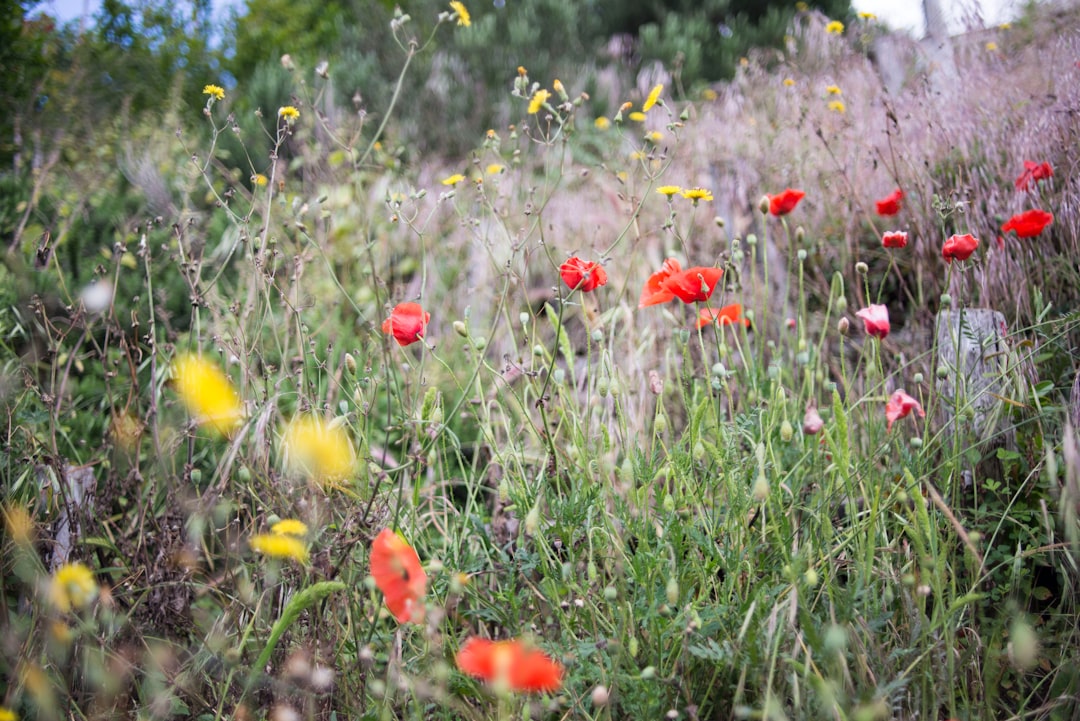
Put simply, a weed is a plant in the wrong place. The more complex questions are, Who decides that it is in the wrong place and on what grounds? In your garden, this is your decision and you can choose to have as many or as few ‘weeds’ as you like or can achieve. However, many plants have thuggish tendencies and will need to be controlled if you want your other plants to flourish too. In deciding whether or not to remove a plant, you will need to identify what it is and balance its merits and faults. This might sound daunting to a new gardener, but as you learn about your local flora, you will find the same culprits appear again and again and knowing what to pull and what to leave becomes easier. Carry your smartphone with you and take pictures to aid identification. You can then keep a record of what grows where and when. Plantsnap is a fantastic phone app that can give you an identification on the spot.
Learning to identify the plants in your garden, and finding out about their habits, can be a fascinating aspect of being a gardener, not least because they will tell you so much about the soil and microclimate that you are growing in. For example, my first lawn was dominated by clover, with very little grass, and we found that this was because it had been laid over an old tarmac carpark. There was little or no drainage, which suited moisture loving clover but drowned the grass. In contrast, the bright blue petals of speedwell suggest that your soil is free draining and tends to be dry. To find out more about what your weeds are telling you try this website.
Know Your Weeds: Virtues and Vices.
The next question to ask yourself is how the plant behaves in your garden. Many weeds are extremely vigorous, which is a good part of why they have been labelled as such. A plant may be useful and beautiful, but if it seeds promiscuously, or grows rampantly swamping your other plants, it may be better to remove it and try to prevent its return. I seriously wish that I had never encouraged aquilegia, which is pretty but seeds everywhere and has very difficult roots for someone with achy hands like me to pull up. For more on how to address this see below.
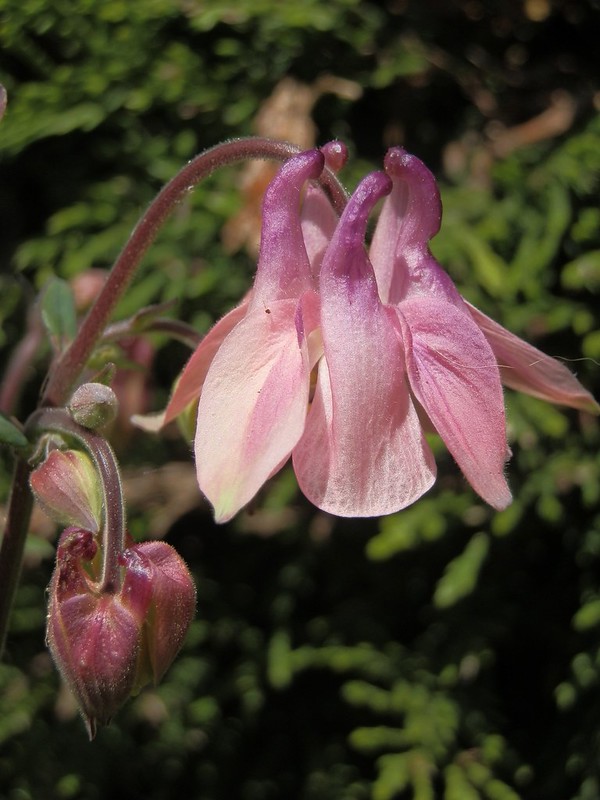
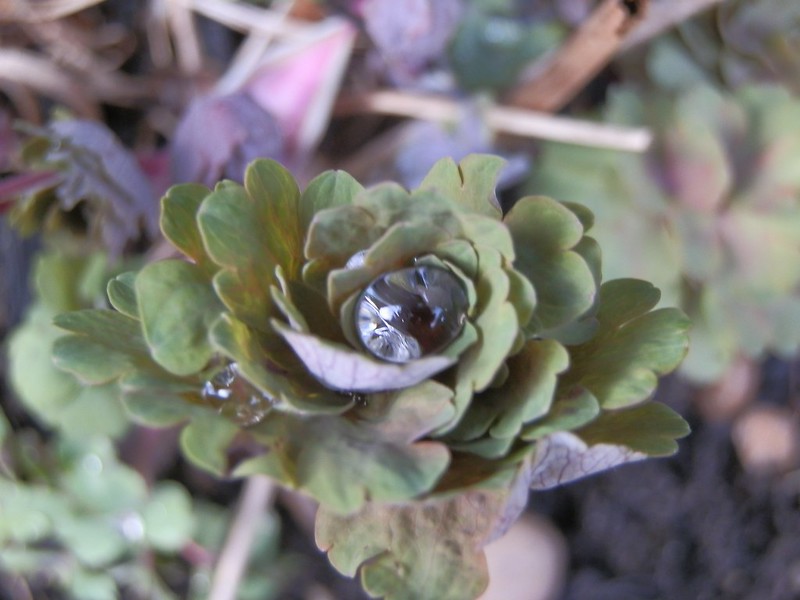
Left - Aquilegea vulgaris or grannies' bonnets
Above - aquilegia leaves form beautiful rosettes that catch raindrops.
Above - aquilegia leaves form beautiful rosettes that catch raindrops.
Weeds to Consider Keeping
Weeds that attract pollinators and predators
A completely weed free garden is inevitably going to be one that also has very few insects and birds. Insects need plants for food and shelter and birds need insects to eat. At the heart of organic gardening lies the principle of developing a garden with a healthy eco-system, in which pests and predators balance each other and reduce the need for drastic interventions. As with weeds, not all bugs are pests. Encouraging insects that are pollinators, and those that predate on the pests, will make your life much easier. Lots of insects means lots of birds, which will also feed on your aphids and caterpillars. In effect, by keeping some weeds you are recruiting an army of under-gardeners to do the heavy and depressing task of pest control.
Leaving plants with flowers that look like upside-down umbrellas, e.g. cow parsley, yarrow and fennel (seen above), will attract legions of hoverflies. The flowers act like miniature landing pads and offer easily accessed pollen. Dandelions, clover and daisies in your lawn will bring in foraging bees in summer and ivy flowers in late autumn provide vital food for bees and many other insects. Its thick growth gives shelter to wrens, robins, blue-tits and blackbirds, all of which eat pests.
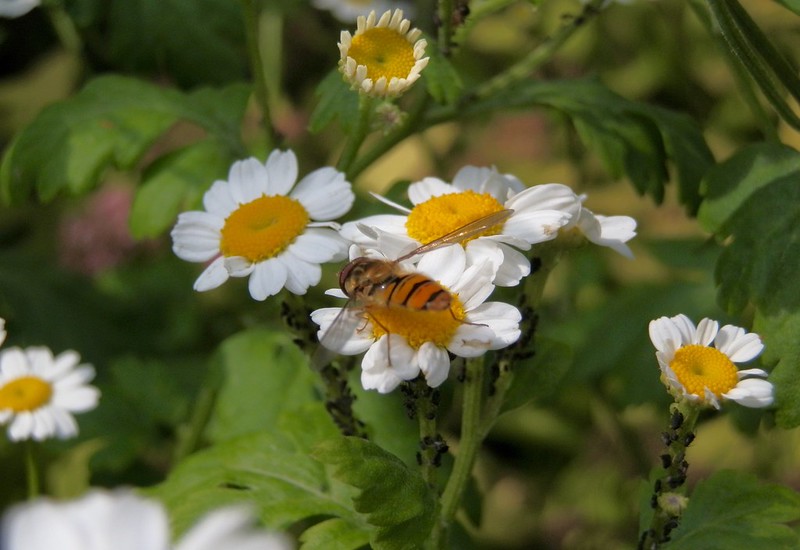
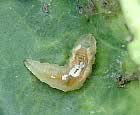
Weeds that are Beautiful and Fill a gap.
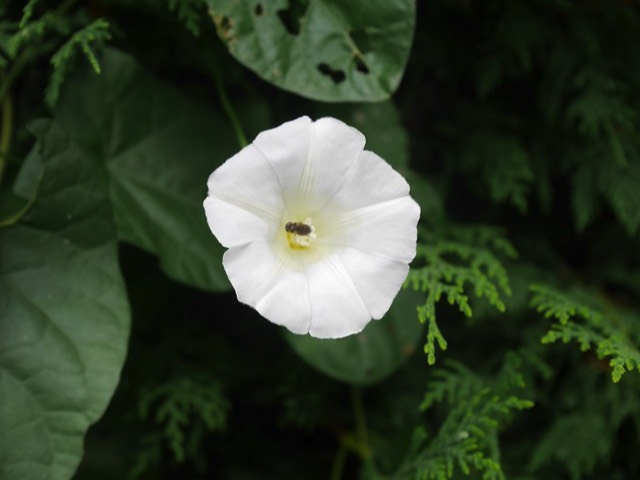
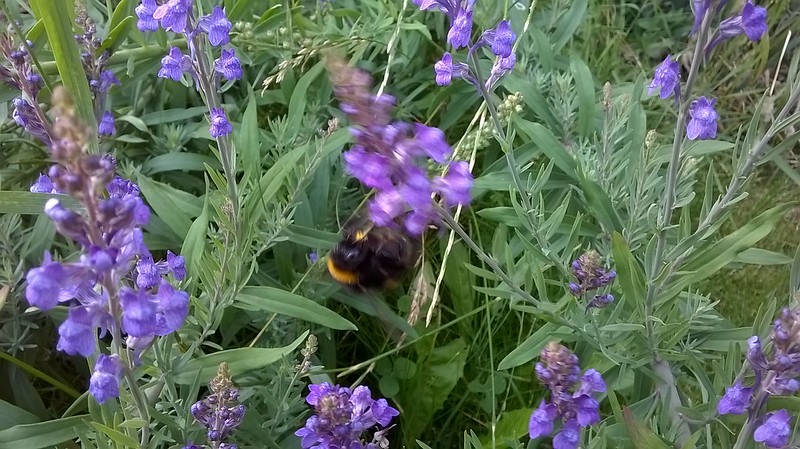
Left - bindweed, Calystegia sepium. A beautiful thug feeding a hoverfly.
Right - purple toadflax, Linarea purpurea, a perfect example of a cultivated garden flower that can become a weed through prolific seeding. Note the happy bee!
Right - purple toadflax, Linarea purpurea, a perfect example of a cultivated garden flower that can become a weed through prolific seeding. Note the happy bee!
Some weeds are stunning. For example, Calystegia sepium, has lovely heart shaped leaves and its large trumpets are a pure white version of the much prized garden flower Morning Glory. It grows rampantly through my ugly Leylandii hedge, its flowers glowing against the dark background in the evening sun. As with most white flowers, the moths are attracted by its blooms and go on to pollinate my crops. However, I am less happy to allow this bindweed growing space in the veg and flower beds as its stems twine up my sweetcorn and roses!
I tried for years to encourage all sorts of garden flowers to grow at the bare, dry base of that Leylandii hedge, until one day I looked at the handful of purple spires and silvery leaves, that I had just pulled out because they were 'weeds', and asked myself, Why? Now this drought hardy purple toadflax fills the gap and buzzes with bees throughout the summer.
Three plants flourish across my garden, being welcome 'weeds' as well as providing a significant contribution to the compost heap. I sowed borage, French marigolds and foxgloves years ago and have never needed to buy seed since. They spread themselves enthusiastically everywhere, all three are beautiful and they serve as magnets for bees and other insects. They pop up in all sorts of serendipitous spaces, where I could never establish a cultivated plant, but they fill a gap perfectly. Fortunately, they are also easy to pull out when they appear in unhelpful spaces. Marigold and borage petals also look stunning in salads or floating in a jug of iced water.
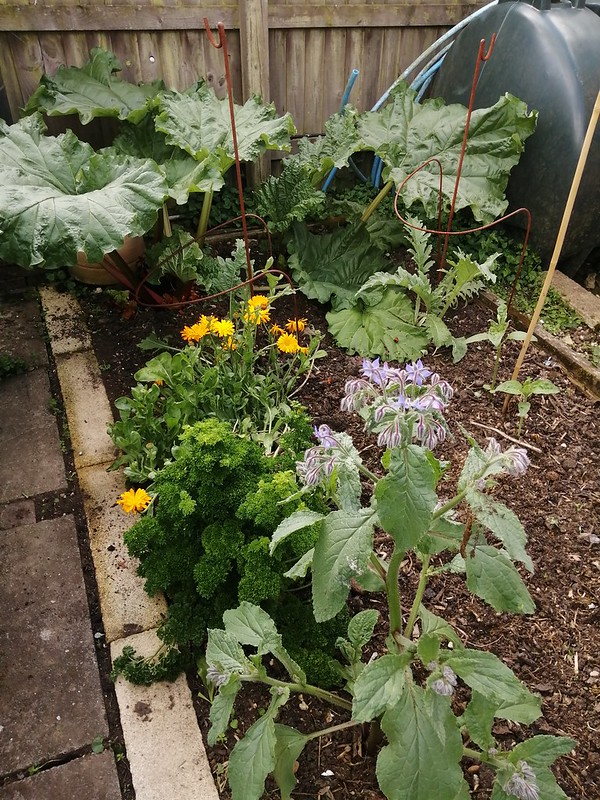
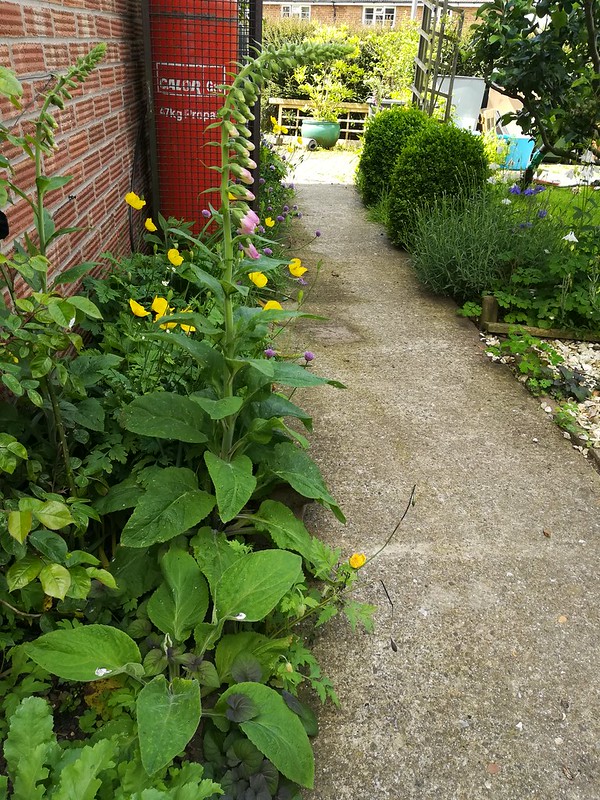
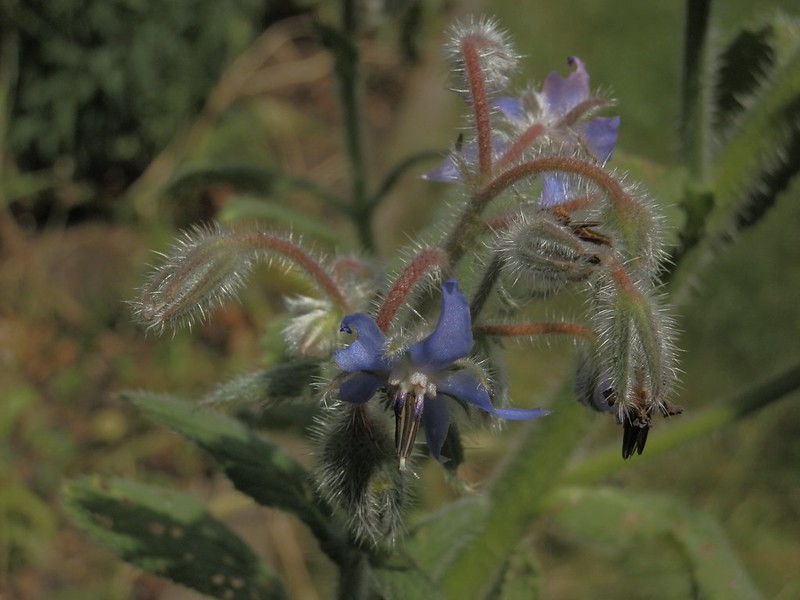
Left - self seeded borage (Borago officinalis) and marigolds (Calendula officials) in the veg patch. I'll pull them out when they get too big
Centre - foxgloves (Digitalis purpurea) and Welsh poppies (Meconopsis cambrica) fill a dark, dry, north-facing border
Right - borage jewels: wonderful for bees or for decorating salads, desserts or drinks.
Centre - foxgloves (Digitalis purpurea) and Welsh poppies (Meconopsis cambrica) fill a dark, dry, north-facing border
Right - borage jewels: wonderful for bees or for decorating salads, desserts or drinks.
Weeds that are Useful / Edible
There are many types of green, leafy weed that make a nutritious and interesting addition to salads. Dandelions have a long history as a salad vegetable, sometimes being forced (covered as young plants) to encourage tender, pale growth.
Weeds are also a really useful source of nutrition for your pets. My chickens absolutely love chickweed (Stellaria media), another weed that has been eaten in salads by people in the past. If you have guineapigs or rabbits, teaching your children to recognise dandelions and groundsel is a good way to delegate that aspect of weed control.
Weeds are also a really useful source of nutrition for your pets. My chickens absolutely love chickweed (Stellaria media), another weed that has been eaten in salads by people in the past. If you have guineapigs or rabbits, teaching your children to recognise dandelions and groundsel is a good way to delegate that aspect of weed control.
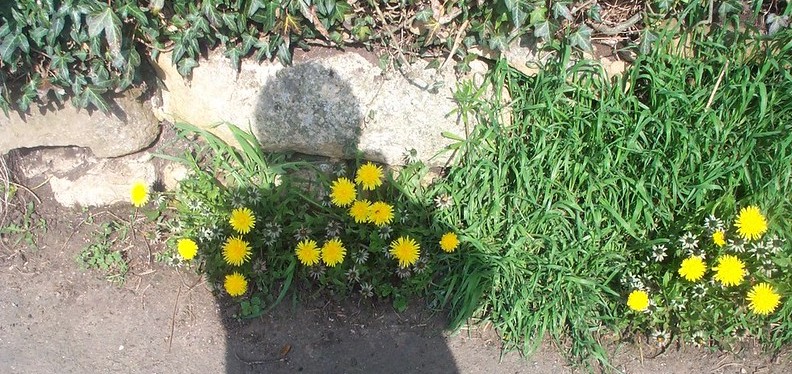
These dandelions fascinated my young son when he took his camera out, looking for something to snap. These leaves will be old, bitter, tough and, more importantly, covered in goodness knows what from passing traffic, people and dogs. Find one safely in your garden and try forcing it under a plant pot instead.
It is important to identify plants accurately before you or your pets eat them and to make sure you pick from places where you can be sure that there is no contamination from chemicals, traffic exhaust or dogs.
A good starting place to learn more about this aspect of your weeds is eatweeds.co.uk, but there is much more available online and in books too.
Some weeds have medicinal purposes, a virtue signalled by the presence of Officinalis in their botanical names. As well as providing salad leaves, dandelion (Taraxacum officinale) has been used traditionally as a diuretic, a function recognised in the French name of pis-en-lit or wet the bed. Once again, be very careful in your use of weeds for medicinal purposes as they can be extremely dangerous. Rubbing a dock leaf on a nettle sting is one thing, but the digoxin contained within foxgloves is potent stuff, lifesaving in carefully measured, prescribed doses as part of a pill, but literally heart stopping if you mess with it. One of my daughter’s guineapigs died and two were seriously ill, after nibbling foxglove leaves through the netting of their run. On this front, it’s better to keep these plants for their interest than to dabble in the dangerous. If this subject interests you there is a wealth of literature and, if you get the chance, visit the poison garden at Alnwick Castle in Northumberland or Chelsea Physic Garden.
Know Your Weeds: How do they Grow?
To know the best way to tackle the plants that you do want to remove or control, it helps to understand how they grow and spread and what conditions they need to achieve this.
Annuals: Prolific Seeders
Annuals are plants that grow from seed, produce flowers and then set new seed all in one year. They are desperate to produce the next generation before winter and so tend to produce huge amounts of seed, spreading it widely on the wind, sticking to passing animals and gardeners, or even using explosive seed pods. The trick here is to spot these and whip them out before the seed-heads develop. In this sense, weeding is not a task to limit to dedicated sessions. Have a bucket of water somewhere out of the way in which you can dump and drown your dandelion and thistle seed heads as you spot them. I often enjoy pottering around the garden in the evening, just to see what is there and spot unexpected beauties. I’ll snap off seed heads as I go, so it doesn’t feel like a chore.
Weed seeds, once disbursed, can remain dormant in the soil for decades, waiting until the conditions are right for germination. You can massively reduce the need for weeding by making sure that these conditions are never right. See below for more on this.
Weed seeds, once disbursed, can remain dormant in the soil for decades, waiting until the conditions are right for germination. You can massively reduce the need for weeding by making sure that these conditions are never right. See below for more on this.
How weeds spread: parachuting seeds
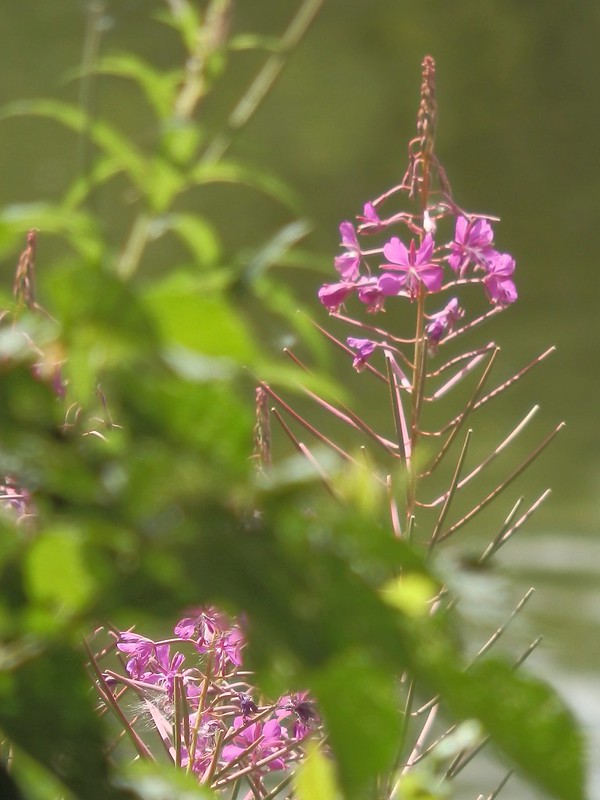
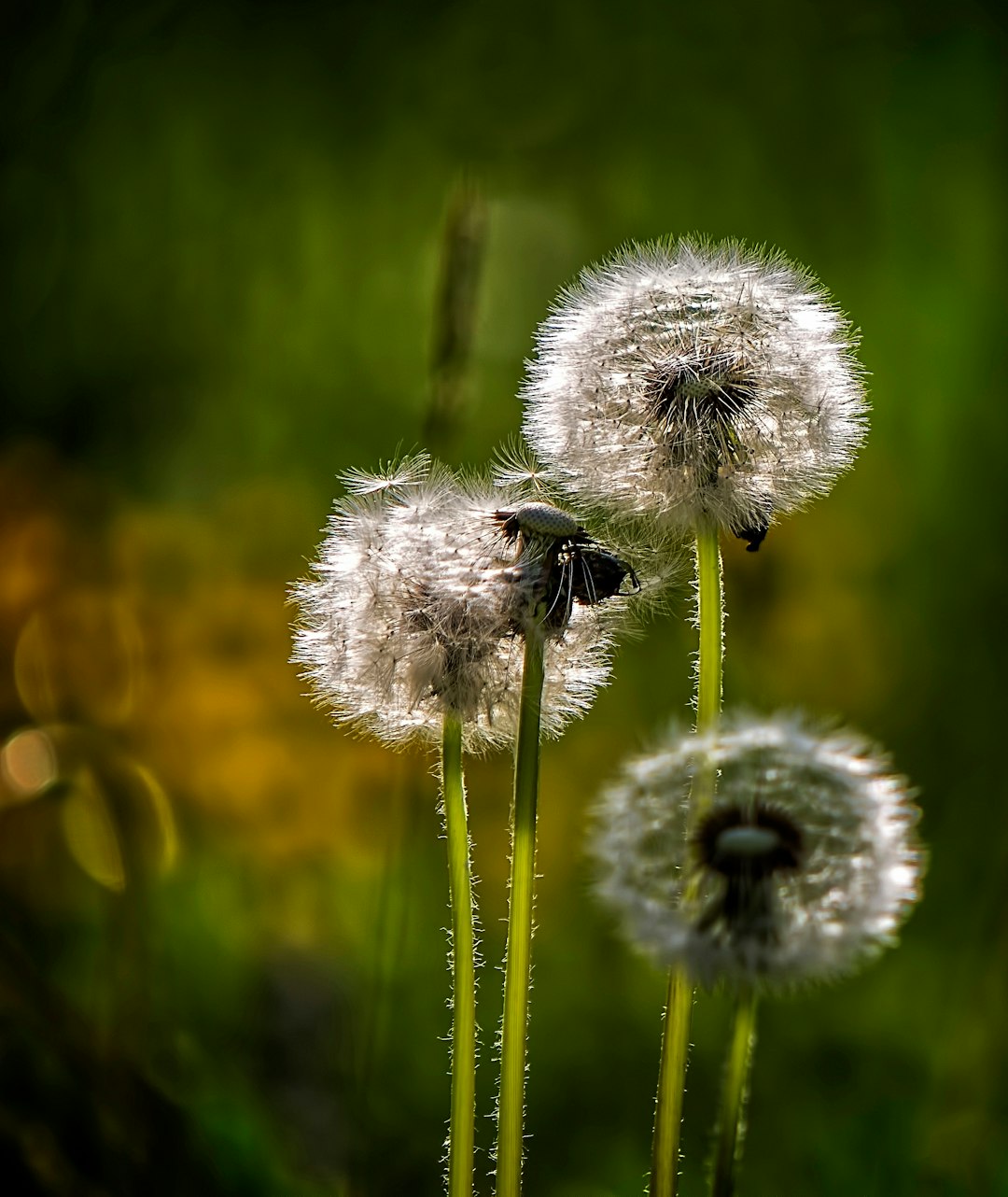
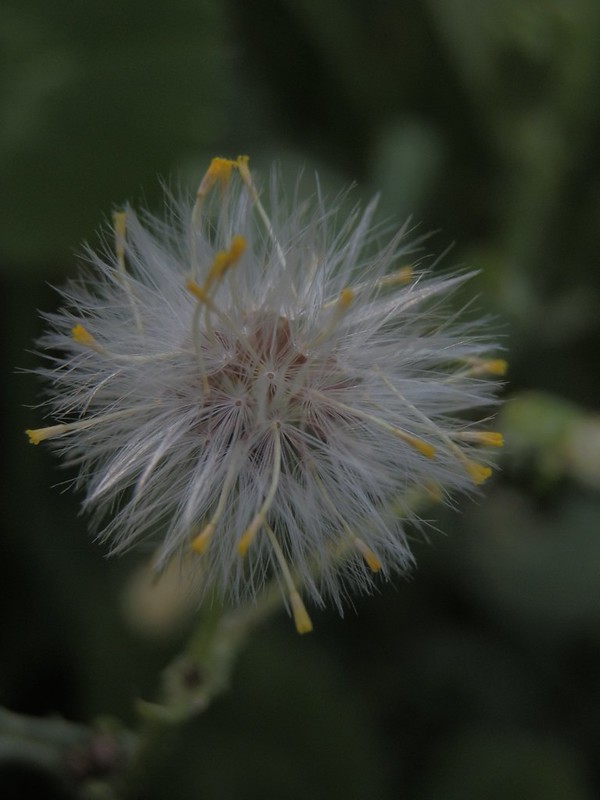
Plants with wind-born seeds: left to right, rosebay willow herb (Chamerion angustifolium), dandelion (Taraxacum officinale) and groundsel. (Senecio vulgaris)
Plants with wind borne seed produce huge numbers of seeds, each with its own parachute, which are caught up by the wind when they are ripe. When a stand of poplar trees releases its seed it can look as if it's snowing.
How weeds spread: explosive seeds
Plants with explosive seed pods:
left to right, dog violet (Viola riviniana), petty spurge (Euphorbia peplus), vetch (Vicia sativa)
left to right, dog violet (Viola riviniana), petty spurge (Euphorbia peplus), vetch (Vicia sativa)
Explosive seeds come in pods that dry out and pop open suddenly, catapulting the seed away from the parent plant. Violets have an extra trick, providing each tiny seed with a package of nutritious oils, so that foraging ants will carry them home to their nests. the oil is eaten, the seed germinates and hey presto, violets appear far from their parents.
How weeds spread: seed shakers
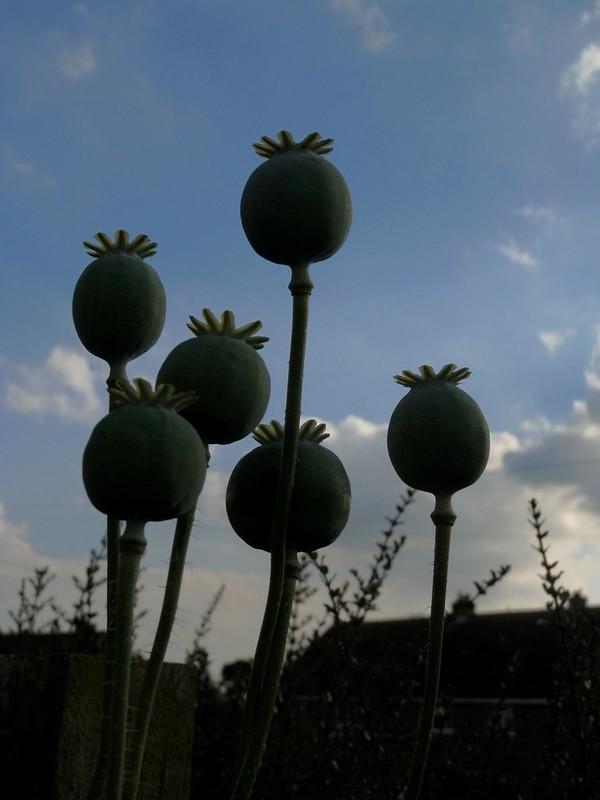
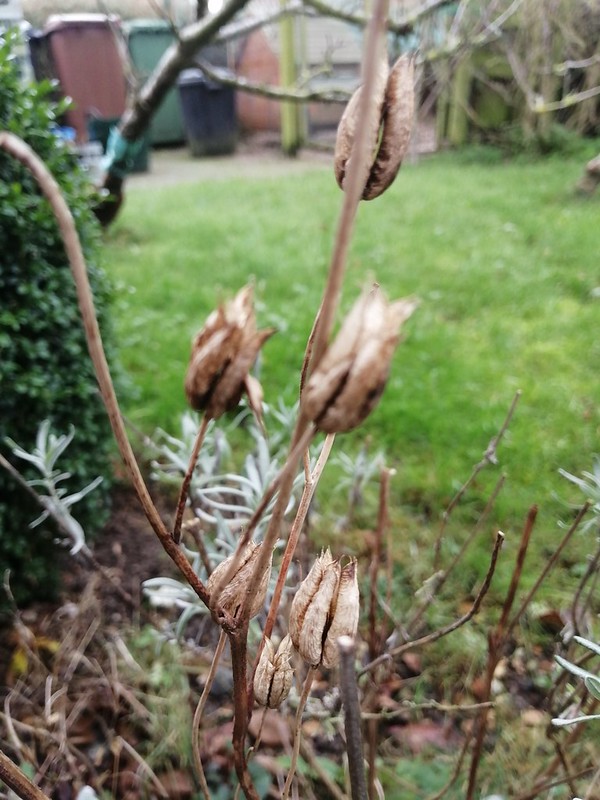
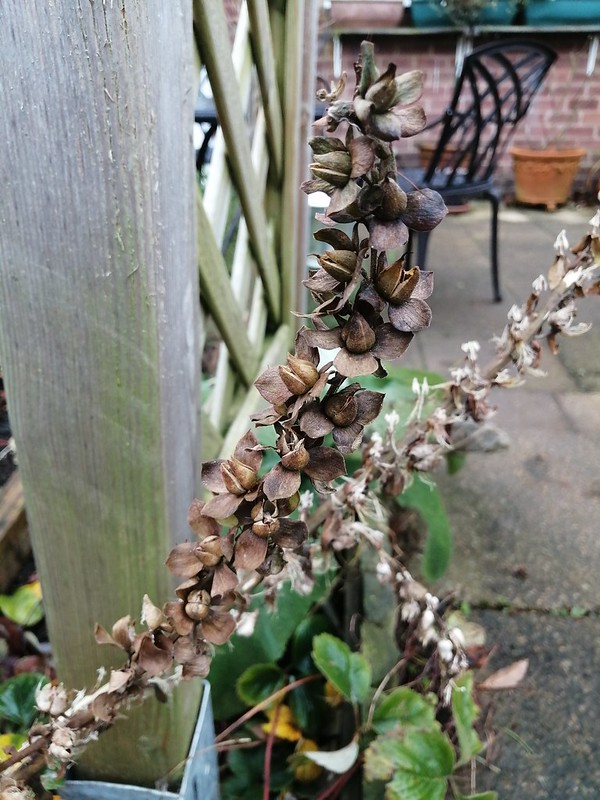
Plants with built in seed shakers: left to right,
poppy (Papaver somniferum/rhoeas/cambrica),
aquilegia (Aquilegia vulgaris),
foxglove (Digitalis purpurea)
This picture shows garden, rather than wild, poppies but it does show the pepper pot seed heads common to all poppies beautifully. There are tiny holes all round the base of the crown, which open once the head and seed is dry. All these species shake their seed around as the heads sway in the wind.
poppy (Papaver somniferum/rhoeas/cambrica),
aquilegia (Aquilegia vulgaris),
foxglove (Digitalis purpurea)
This picture shows garden, rather than wild, poppies but it does show the pepper pot seed heads common to all poppies beautifully. There are tiny holes all round the base of the crown, which open once the head and seed is dry. All these species shake their seed around as the heads sway in the wind.
These seeds are also spread by the wind, but this time out of specialised shakers. Like the explosive seed pods, they dry out when the seed is ripe, which opens tiny holes through which the seeds fall as the wind shakes the pod. The seed tends to be tiny to facilitate this.
Perennials: Well Rooted
These are a much harder group to address. They are the plants that store up energy in underground roots, to enable them to survive the winter, and then pop back up again every spring. Some, particularly grasses, even keep growing all winter. Any plant with a root thicker than a hair is one to be suspicious of. Some have huge tap roots that dive down several metres, others, like couch grass and ground elder, create dense underground mats of roots that weave through your treasured plants, stealing their water and nutrients. Incidentally, ground elder was introduced by the Romans as a salad crop, so maybe eating it will help.
To make things harder, perennials also set seed. Thistles and dandelions will blow in on the wind and then establish hefty roots. If you break these roots, every piece that stays in the ground will grow into a new plant. Beware of people promoting rotavators as an easy option: they chop the roots up into a thousand tiny pieces, leaving them in the ground where they will produce a thousand new plants. The key to managing perennials lies in cutting off their food supply to the roots to weaken and eventually starve them. Again, see below for more on this.
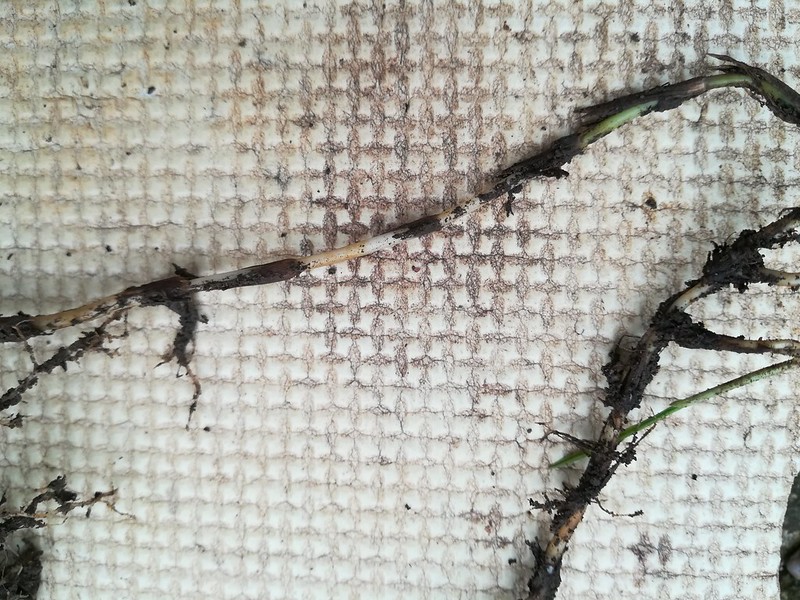
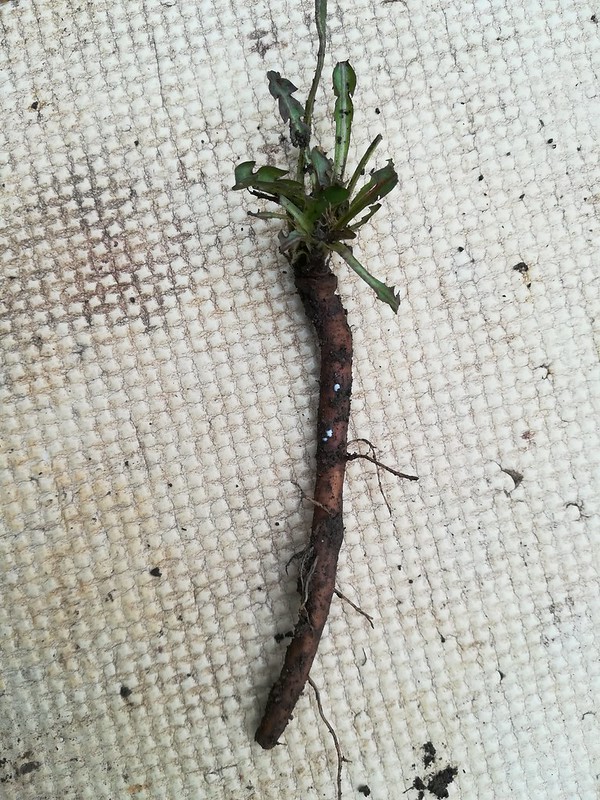
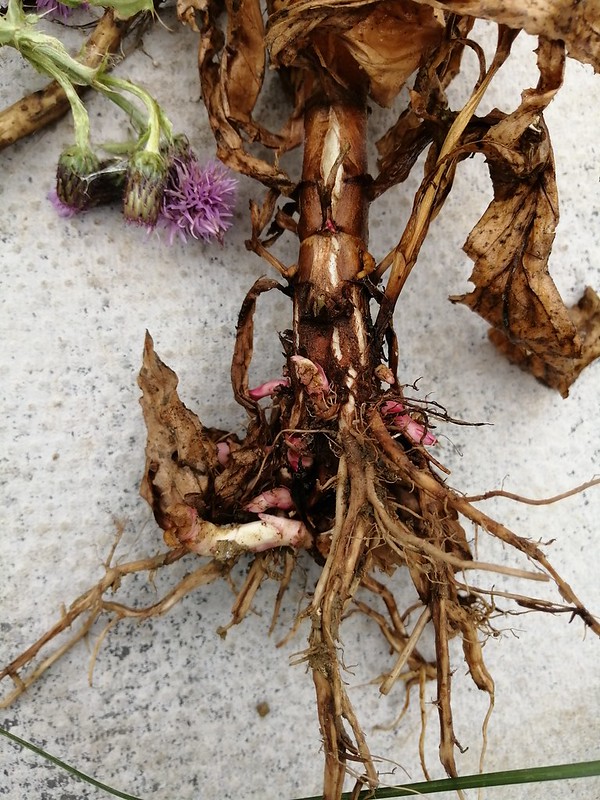
Common perennial weed roots, left to right:
couch grass (Elytrigia repens),with its memorable zebra striped roots,
a dandelion tap root (the plant is growing back having had its top chopped off once, hence the big root/small plant,
rosebay willow herb, which thrives through a combination of rhizomatous roots, which produce more roots and shoots underground, and 'parachute' seeds that can drift for miles on the wind.
couch grass (Elytrigia repens),with its memorable zebra striped roots,
a dandelion tap root (the plant is growing back having had its top chopped off once, hence the big root/small plant,
rosebay willow herb, which thrives through a combination of rhizomatous roots, which produce more roots and shoots underground, and 'parachute' seeds that can drift for miles on the wind.
Weeding out the Unwelcome
Your approach to weeding depends on how much ground you want to clear, which weeds are growing in it and what they are growing through and around.
It also depends on your own capabilities and reserves of time and energy. Weeding does not have to mean lots of heavy digging or weedkiller.
It also depends on your own capabilities and reserves of time and energy. Weeding does not have to mean lots of heavy digging or weedkiller.
Mulching
All the weeds in your garden need light to survive and without it they will eventually wither away. Mulching is a term used for covering the ground, to exclude light from the soil surface and any weeds. It also protects the soil surface from evaporation, keeping it moist and reducing the need for watering.
Mulching Annuals Annuals are quicker to succumb to this method, having fewer reserves to call on in an emergency. If you hoe their tops off they will die and rot into the soil in just a few weeks. Do chop their tops from their roots though or they will thank you for the feed and push back up to the sunshine.
Mulching Perennials These plants are much tougher and will survive for months without light, so you will need to be patient. Remember, most of them are designed to survive winter by losing their tops and hiding underground in root form. If you have a really heavy invasion of couch grass, brambles or bindweed you will need to cut back the top growth to ground level with a scythe or strimmer, then keep it covered for at least a year and preferably two. It’s a long time to wait, but at least you are tackling the weeds in that time instead of exhausting yourself or fretting over not doing anything.
Mulching is an approach that is much less work than digging out all the roots, but is still heavy going. Can you invest in a couple of hours of a professional or do you have family or neighbours who could help?
Maybe you could offer some motivation and make your own contribution by keeping the workers supplied with tea/cake/beer/bacon sarnies/whatever gets them going. A job like this can be fun when a group of people are working together. It might be something that your local scout group could help with, to raise some funds for charity. Don't assume that every job has to be done by you or that it has to cost a fortune. Learn to think creatively.
Mulching Annuals Annuals are quicker to succumb to this method, having fewer reserves to call on in an emergency. If you hoe their tops off they will die and rot into the soil in just a few weeks. Do chop their tops from their roots though or they will thank you for the feed and push back up to the sunshine.
Mulching Perennials These plants are much tougher and will survive for months without light, so you will need to be patient. Remember, most of them are designed to survive winter by losing their tops and hiding underground in root form. If you have a really heavy invasion of couch grass, brambles or bindweed you will need to cut back the top growth to ground level with a scythe or strimmer, then keep it covered for at least a year and preferably two. It’s a long time to wait, but at least you are tackling the weeds in that time instead of exhausting yourself or fretting over not doing anything.
Mulching is an approach that is much less work than digging out all the roots, but is still heavy going. Can you invest in a couple of hours of a professional or do you have family or neighbours who could help?
Maybe you could offer some motivation and make your own contribution by keeping the workers supplied with tea/cake/beer/bacon sarnies/whatever gets them going. A job like this can be fun when a group of people are working together. It might be something that your local scout group could help with, to raise some funds for charity. Don't assume that every job has to be done by you or that it has to cost a fortune. Learn to think creatively.
Approaching a Large or Complicated Area
If you have a large area to clear, or it is a complicated mixture of weeds and plants you want to keep, it is probably a situation where you need to,
a) bring in some help.
b) learn to look at it differently and appreciate the wildlife.
c) block the view with a well-placed climber, shrub or large plant in a pot until such time as you have enough energy to tackle it.
d) tackle it one small patch at a time and mulch the clear areas to prevent regrowth. You might plant other things before mulching too. Don’t ever leave a weeded patch empty or all your efforts will be wasted as the seeds you have exposed to the light by disturbing the soil burst into life.
a) bring in some help.
b) learn to look at it differently and appreciate the wildlife.
c) block the view with a well-placed climber, shrub or large plant in a pot until such time as you have enough energy to tackle it.
d) tackle it one small patch at a time and mulch the clear areas to prevent regrowth. You might plant other things before mulching too. Don’t ever leave a weeded patch empty or all your efforts will be wasted as the seeds you have exposed to the light by disturbing the soil burst into life.
Mulching Large Areas
If you want to clear a large area and then plant it up later, try,
Flattened cardboard boxes - overlapping to keep out the light and weighed down with heavy stones or bricks. Really big ones can be scavenged from furniture or cycle shops. The boxes eventually rot into the soil and so won’t need removing. This method is even better if you can cover the boxes with 2-3 inches of compost or manure, but this is only suitable for fit and able people with access to lorry loads of the stuff. The advantage is cardboard is free.
Heavy duty plastic sheeting or weed suppressant fabric - an expensive option and not great in terms of sustainability. It keeps the rain out as well as the light, drying the weeds and killing them faster, but this is not good for the other life in your soil.
Don’t be tempted to use old carpet.
Many people do, particularly on allotments, but there are some seriously nasty chemicals used in making and protecting carpets, which you don’t want leaching into your soil. Also, they get sodden and weeds start to grow in the pile if left too long, so they can be very difficult to lift and dispose of once you’ve finished with them.
Flattened cardboard boxes - overlapping to keep out the light and weighed down with heavy stones or bricks. Really big ones can be scavenged from furniture or cycle shops. The boxes eventually rot into the soil and so won’t need removing. This method is even better if you can cover the boxes with 2-3 inches of compost or manure, but this is only suitable for fit and able people with access to lorry loads of the stuff. The advantage is cardboard is free.
Heavy duty plastic sheeting or weed suppressant fabric - an expensive option and not great in terms of sustainability. It keeps the rain out as well as the light, drying the weeds and killing them faster, but this is not good for the other life in your soil.
Don’t be tempted to use old carpet.
Many people do, particularly on allotments, but there are some seriously nasty chemicals used in making and protecting carpets, which you don’t want leaching into your soil. Also, they get sodden and weeds start to grow in the pile if left too long, so they can be very difficult to lift and dispose of once you’ve finished with them.
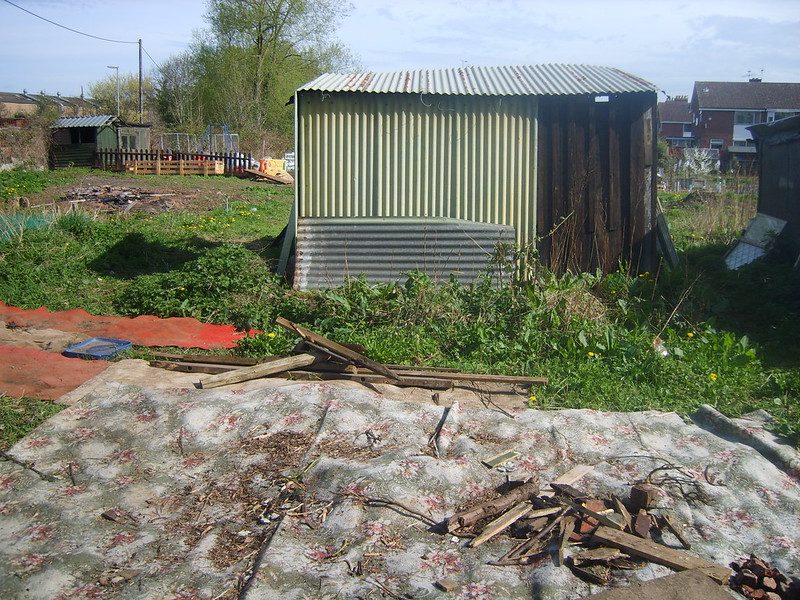
The Weedkiller Question
Please don’t be persuaded to use weed killer
A large area of weeds is very daunting, and most people are tempted to use weed killer, ‘just to get started’. Neighbours and friends can be particularly insistent that this is the best way to proceed. The bottles are designed to convince you that it is all perfectly safe and that the chemicals become harmless as soon as they hit the soil. This message has been so successful that it is quite common to see people out spraying with no protective clothing, on windy days and around other people. I once saw a man spraying the path that I was walking on at a major national heritage site. He was dodging in and out of the visitors and their dogs, while the spray drifted over us in the breeze.
This reassuring message is not true. Recent research has shown that glyphosate, the commonest weed killer in domestic and agricultural use, is a carcinogen. An alarming level and frequency of herbicides (and pesticides) has also been shown to be present in our food and water as it is drawn up into crops and washes out of soil into our water courses. Also bear in mind that weed killers kill everything in the soil, not just the target plants, and that includes the microscopic life that works with plants’ roots to help them access nutrients. Click here to read the Soil Association’s information on glyphosate and soil health. If you are concerned that chemicals may be a contributor to your illness, is worth a bit of time browsing the internet to find out more about this.
A large area of weeds is very daunting, and most people are tempted to use weed killer, ‘just to get started’. Neighbours and friends can be particularly insistent that this is the best way to proceed. The bottles are designed to convince you that it is all perfectly safe and that the chemicals become harmless as soon as they hit the soil. This message has been so successful that it is quite common to see people out spraying with no protective clothing, on windy days and around other people. I once saw a man spraying the path that I was walking on at a major national heritage site. He was dodging in and out of the visitors and their dogs, while the spray drifted over us in the breeze.
This reassuring message is not true. Recent research has shown that glyphosate, the commonest weed killer in domestic and agricultural use, is a carcinogen. An alarming level and frequency of herbicides (and pesticides) has also been shown to be present in our food and water as it is drawn up into crops and washes out of soil into our water courses. Also bear in mind that weed killers kill everything in the soil, not just the target plants, and that includes the microscopic life that works with plants’ roots to help them access nutrients. Click here to read the Soil Association’s information on glyphosate and soil health. If you are concerned that chemicals may be a contributor to your illness, is worth a bit of time browsing the internet to find out more about this.
Farmers tend to use glyphosate to speed the drying of cereals before the harvest as well as to control weeds.
The other misleading message encouraged by the big agrochemical companies, is that spraying your ground with weed-killer is the easy answer: one spray and they’re gone. If all you have is an overgrowth of annuals on otherwise clear soil, they may only need one treatment. However, most people use weed killer for tougher perennials, which will need repeated spraying until there is no more energy left in their roots and the toxins overcome them. After one spray, they might sulk a bit, but will then come back for more, leaving you with seriously damaged soil and a bill for more chemicals, on top of the protective mask and gloves you should already have bought.
For Smaller Areas and Between Plants
It’s better to clear what you can by hand first, a little at a time, as much as you can comfortably manage, and cover the cleared ground as you go to stop any more seeds from germinating.
Try mulching with,
compost, manure or spent mushroom compost, 3-4 inches thick. This is good for both vegetable and flower beds. The worms will gradually draw the mulch down into the soil, improving its structure and fertility, so you will need to renew it each year. The up side is that your soil will improve and your plants et better each year.
bark or wood chippings, 3-4 inches thick. This is better for under shrubs and flower beds, which won’t be disturbed. You don’t want the bark to become mixed into the soil as it will draw the nutrients away from your plants as it decomposes. Some people put down a layer of weed suppressant fabric and less bark, but the fabric often gets uncovered as birds and animals fossick in the bark. This looks ugly and is less effective and sustainable than a good, thick layer of bark.
Try mulching with,
compost, manure or spent mushroom compost, 3-4 inches thick. This is good for both vegetable and flower beds. The worms will gradually draw the mulch down into the soil, improving its structure and fertility, so you will need to renew it each year. The up side is that your soil will improve and your plants et better each year.
bark or wood chippings, 3-4 inches thick. This is better for under shrubs and flower beds, which won’t be disturbed. You don’t want the bark to become mixed into the soil as it will draw the nutrients away from your plants as it decomposes. Some people put down a layer of weed suppressant fabric and less bark, but the fabric often gets uncovered as birds and animals fossick in the bark. This looks ugly and is less effective and sustainable than a good, thick layer of bark.
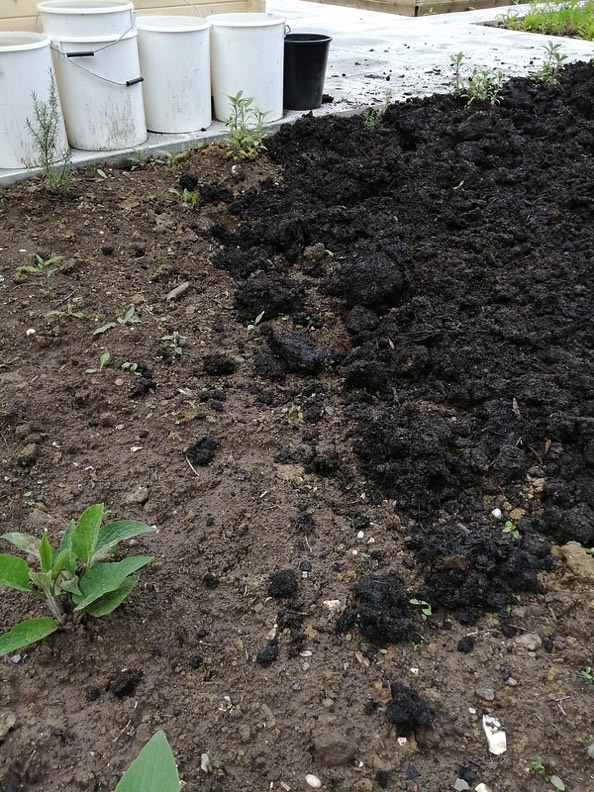
We mulched some very poor, thin, badly drained soil on the community allotment with a huge quantity of composted grass clippings and leaves donated by a local man with a large garden. Look at the difference in colour!
The basis of organic gardening is to feed your soil, not your plants. Good soil is dark, because it contains lots of organic matter, called humus. This holds lots of nutrients, and water as well as having spaces for air pockets.
The basis of organic gardening is to feed your soil, not your plants. Good soil is dark, because it contains lots of organic matter, called humus. This holds lots of nutrients, and water as well as having spaces for air pockets.
Tools and Positions.
Top Tip
Avoid spending valuable time and energy hunting for hand tools you’ve just put down. Buy a role of neon coloured duck-tape and wrap a piece around the handles. The unnatural colour jumps out against the dark soil and plants.
Avoid spending valuable time and energy hunting for hand tools you’ve just put down. Buy a role of neon coloured duck-tape and wrap a piece around the handles. The unnatural colour jumps out against the dark soil and plants.
Choosing the right tool
Buy tools that feel comfortable to handle and suit your individual needs
The best approach to this, as ever, depends on your particular abilities and limitations. If you are thinking of investing in expensive tools, particularly those that are advertised as suitable for people with disabilities, try and test them out first if you can. Any tool should feel comfortable in your hand and come to feel like an extension of yourself. You may think that a trowel is a trowel is a trowel, but they come in many shapes, sizes, handle lengths and weights. You'll know when you're holding the right one for you.
Many tools sold as being suitable for people with disabilities are very hard to manage, particularly when they have long handles. They are designed to help you reach, without taking into account the strength and dexterity needed to control a tool like this effectively; imagine trying to insert a key in a lock if the shaft was two feet long!
If your hands are weak, short handled tools are often much easier to use, as there is less weight on your wrists and fingers and you have more control than with a long handle. If you can, get down on a kneeler; some come with useful handles to haul yourself up with. If this is difficult or uncomfortable, gardening in a raised container or bed may be the answer. Beware of sitting down to weed and having to twist your torso to reach. This puts huge strain on your lower back.
If you find it difficult to bend over, a lightweight, long-handled hoe might be the easiest option for weeding at ground level. I like a push-pull type, which doesn’t require lifting between each stroke; you can literally push and pull it backwards and forwards just under the soil surface, where it slices weed tops off. In the spring and summer, I keep mine propped up next to my soft fruit bed so I can do a few strokes when I pass. I chop off any new growth before it has time to get established. As ever, little and often is best for me and my plants.
Many tools sold as being suitable for people with disabilities are very hard to manage, particularly when they have long handles. They are designed to help you reach, without taking into account the strength and dexterity needed to control a tool like this effectively; imagine trying to insert a key in a lock if the shaft was two feet long!
If your hands are weak, short handled tools are often much easier to use, as there is less weight on your wrists and fingers and you have more control than with a long handle. If you can, get down on a kneeler; some come with useful handles to haul yourself up with. If this is difficult or uncomfortable, gardening in a raised container or bed may be the answer. Beware of sitting down to weed and having to twist your torso to reach. This puts huge strain on your lower back.
If you find it difficult to bend over, a lightweight, long-handled hoe might be the easiest option for weeding at ground level. I like a push-pull type, which doesn’t require lifting between each stroke; you can literally push and pull it backwards and forwards just under the soil surface, where it slices weed tops off. In the spring and summer, I keep mine propped up next to my soft fruit bed so I can do a few strokes when I pass. I chop off any new growth before it has time to get established. As ever, little and often is best for me and my plants.
Many thanks are due here to the wonderful Shirley Martin-Abel, a horticultural therapist who taught me, and our Garden Organic Master Gardener volunteers, so much about finding the right tools to suit everyone.
Spend your money wisely
Tools vary hugely in cost, so think about how much you have available to spend and try to get as good a tool as you can afford. A really good tool will last for decades if you look after it, and one that minimises stress and strain will look after you in return.
It's possible to get a spade or some secateurs in some big chain stores for only £5.00, but it will almost certainly buckle or break very soon after you start to use it and then your money is wasted.
If cost is a worry or a barrier to growing, buying second hand from car boot or market stalls may be a better bet. Alternatively, ask around your friends to see if anyone knows someone with unused tools. It's quite common for people to find they have a shed full of tools to dispose of when an elderly relative dies or downsizes. I volunteer at our local community allotment and we have a shed full of tools that were donated after sitting unused in someone's shed for years.
It's possible to get a spade or some secateurs in some big chain stores for only £5.00, but it will almost certainly buckle or break very soon after you start to use it and then your money is wasted.
If cost is a worry or a barrier to growing, buying second hand from car boot or market stalls may be a better bet. Alternatively, ask around your friends to see if anyone knows someone with unused tools. It's quite common for people to find they have a shed full of tools to dispose of when an elderly relative dies or downsizes. I volunteer at our local community allotment and we have a shed full of tools that were donated after sitting unused in someone's shed for years.
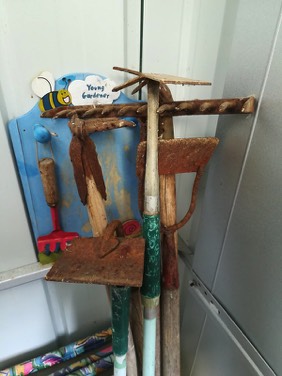
Just some of the donated tools in our community allotment shed. These are child sized and in need of some serious TLC
Useful Weeding Tools
A Dandelion Trowel
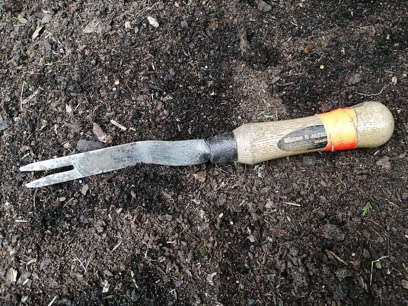
This is my favourite hand tool, which is like a long, slim, two-pronged fork with a bend in the blade. It is small enough to reach into the smallest spaces to lever out weeds and I can use the side as a hoe. It really comes into its own gently teasing out couch grass roots without breaking them. The handle sits comfortably in my hand and it’s so versatile that I don’t have to keep hunting for different tools.
A Hand Fork and Trowel
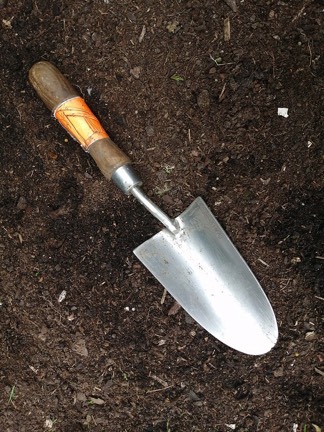
A good sturdy, hand-sized fork enables you to dig down and loosen weed roots without creating the big hole that a trowel produces. You are also less likely to damage any bulbs hidden below the soil's surface. Trowels are better used for making holes for planting, although they are handy for digging down alongside a chunky dandelion or dock root to lever it out of the soil. Be careful though, levering out roots is hard on the hands so it may be better to excavate and loosen the soil around a big root as far down as you can before trying to pull it out.
Grandpa’s Weeder
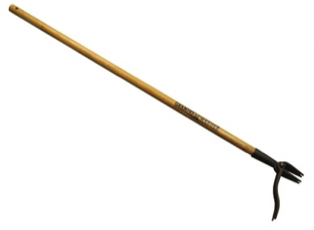
I recently bought my mother one of these long-handled tools, which has a sharp blade to pierce down alongside a perennial root and a lever, which lifts the root out with very little effort. It works beautifully.
A Flame Gun
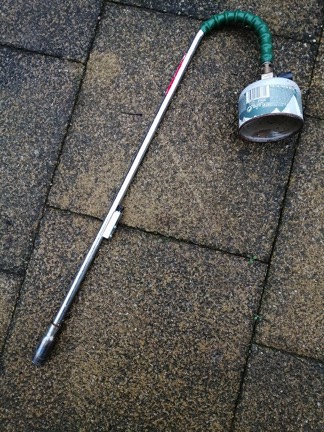
A long-handled flame gun is great fun and very effective for areas like drives and patios. This tool looks like a chef's blowtorch*, but is long enough to reach the ground comfortably as you walk along. The heat kills annuals and their seed heads. Perennials will need repeat treatment but will eventually give up. On the downside, this is a fossil fuel tool, so not high on the sustainable gardening list. It’s not great for weeding in between plants as you may scorch them and be careful not to use it close to dry vegetation or you may start a fire and clear a far greater area than you intended.
*I have on occasion used mine to toast the marzipan on an Easter simmnel cake, much to the amused despair of my children. I did do it safely outside!
A Kettle of Water.

Boiling water is just as effective on drive and patio weeds as weed-killer, without the expense and danger of chemicals. Perennials need regular treatment until they give up whether you use weed-killer, fire or boiling water. Be careful not to scald yourself if your hands are weak and don’t do this in sandals. It’s too easy to lose concentration and weed your toes!
Keeping on Top of Your Weeds
Here are four key things to remember in order to minimise the regrowth of weeds once you have cleared your ground.
Don't leave your soil empty
Once you have cleared a patch of ground, make sure you cover it with a mulch or plant something in it immediately. Try and plan your gardening time to include this. Clear a little, plant a little, clear a little, plant a little. Don’t leave all the planting or mulching until the end. It is so easy to get tired and walk away, only to find you can’t come back as soon as you expected, and the weeds have taken over again.
Nip any problems in the bud
Pick out problem weeds as soon as you spot them, especially those with seed heads just ready to fly/explode. If all you can do is nip the head off, do that and remove the plant later.
Don’t dig it
I’ll write more on this elsewhere but turning over your soil brings lots more seeds to the surface, ready to germinate in the light. Disturb your soil as little as possible.
Water your plants not the weeds
In summer, water close to the plants you want and don’t water the whole surface as you’ll encourage the weed seeds to germinate. A layer of dry soil inhibits germination and makes it easier to run a hoe across any survivors.
and even more importantly than all of this:
LISTEN TO YOUR BODY AND STOP BEFORE YOU GET TIRED!
Don't leave your soil empty
Once you have cleared a patch of ground, make sure you cover it with a mulch or plant something in it immediately. Try and plan your gardening time to include this. Clear a little, plant a little, clear a little, plant a little. Don’t leave all the planting or mulching until the end. It is so easy to get tired and walk away, only to find you can’t come back as soon as you expected, and the weeds have taken over again.
Nip any problems in the bud
Pick out problem weeds as soon as you spot them, especially those with seed heads just ready to fly/explode. If all you can do is nip the head off, do that and remove the plant later.
Don’t dig it
I’ll write more on this elsewhere but turning over your soil brings lots more seeds to the surface, ready to germinate in the light. Disturb your soil as little as possible.
Water your plants not the weeds
In summer, water close to the plants you want and don’t water the whole surface as you’ll encourage the weed seeds to germinate. A layer of dry soil inhibits germination and makes it easier to run a hoe across any survivors.
and even more importantly than all of this:
LISTEN TO YOUR BODY AND STOP BEFORE YOU GET TIRED!
My illness has meant that I have had to give up my work and so I am now looking to find a new career through my writing. If you have enjoyed this page and would like to encourage me to produce more, click the coffee cup below to make a small donation; no strings, no fuss, just a little, 'Thanks, keep it up.'
You can also help by sharing this page on your social media.
